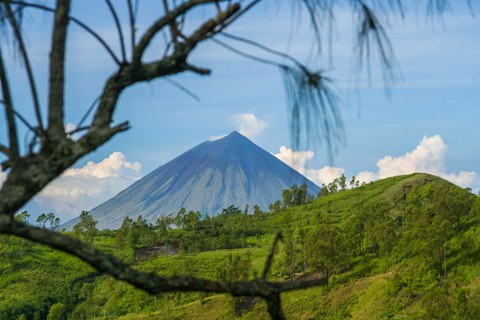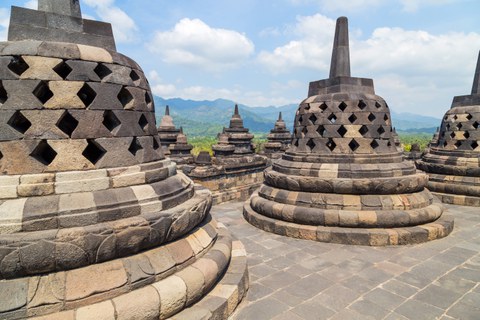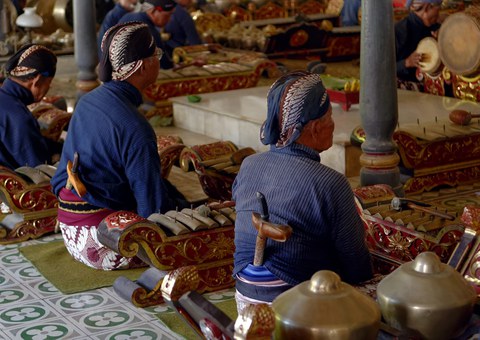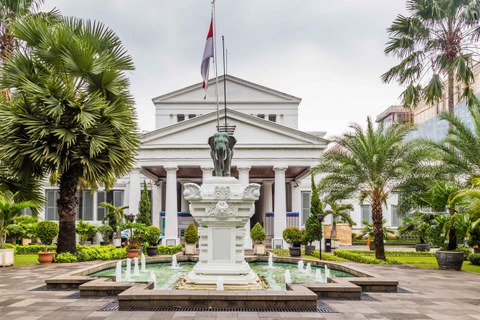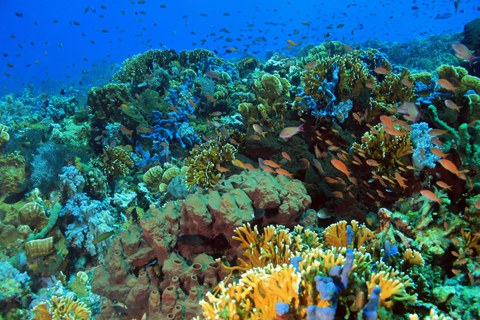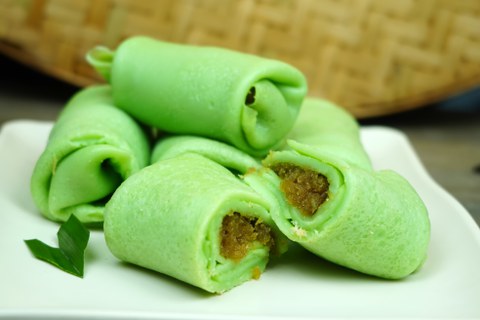Partner Country of the Month December 2022: Indonesia
How to summarise Indonesia? "Unity in diversity" is the Indonesian motto, and with good reason. The fourth most populous country in the world consists of over 17,000 islands. About 6,000 of them are inhabited, and virtually every major island has its own culture and ethnic groups. Of these, splendid Bali with its rich Hindu culture is probably the most well-known. Indonesia’s fascinating cultural diversity meets a unique nature with tropical rainforests, volcanoes, and coral reefs. Add to that the hospitality of Indonesians – let’s go to Southeast Asia!
With the "Partner Country of the Month" campaign, we want to shine a spotlight on the wide diversity of countries, regions and partner universities of TU Dresden that our students can explore during a semester abroad.
Table of contents
General facts and figures about Indonesia
Capital: Jakarta, on the island of Java
Population: 273.5 million (2020)
Official language: Indonesian
Main islands: Sumatra, Java, Borneo (also called Kalimantan), Sulawesi, New Guinea
National holiday: August 17th – Day of independence from the Netherlands
Currency: Rupiah (IDR / Rp)
You can find further facts, figures and information on wikipedia, on indonesia.travel, or e.g. on wikivoyage.
Language matters
- Good … morning / afternoon / evening – Selamat … pagi / sore / malam
- Hello, how are you? – Halo, apa kabar?
- My name is … – Nama saya …
- Nice to meet you – Senang berkenalan denganmu
- Excuse me – Permisi
- I don’t understand – Saya tidak mengerti
- Thank you – Terima kasih
- See you – Sampai jumpa
Indonesian, or Bahasa Indonesia, is Indonesia's official language, but only about 7-8% of the population speak it natively (mainly on Java). At home, most Indonesians speak one of over 700 local languages, with Indonesian serving as the main lingua franca. It's the language used in media, administration, education and all other contexts where Indonesians of different ethnic backgrounds come together.
Bahasa Indonesia strongly resembles the language of the neighbouring Malaysia, Bahasa Malaysia. They're so similar that, despite the official distinction, linguists consider them merely variants of the same language. The main differences lie the vocabulary for concepts that emerged during or after both countries' long colonial period, such as many technological terms.
At our partner university, Indonesian is the main language of instruction, but there are also many courses taught in English. Therefore, English proficiency is the only language requirement for an exchange. However, many Indonesians don't speak English, so learning some basic Indonesian will help you get around. And the Indonesians you meet will be thrilled!
Indonesian is quite easy to learn. The pronunciation is straightforward, and unlike many other Asian languages, it's written in the Latin alphabet. The grammar is also relatively simple, so you will quickly be able to start talking. Here you can find an overview of learning options and recommendations.
Did you know that ....?
- of all cities worldwide, Jakarta is the one that’s most often geo-tagged in Instagram Stories? Instagram is extremely popular in Indonesia, Stories especially, more than in any other Asian country. Indonesians post about twice as many Stories as the global average. Why is that? This casual way of sharing with many people at once just seems to fit well with the culture. Indonesians are generally very sociable and have large social circles.
-
Indonesia is famous for its variety of ornate traditional textiles? One example of this is batik, a dyeing technique similar to how Easter eggs are decorated in parts of Europe. Artisans apply patterns to the fabric with liquid wax. In the subsequent dyeing, these areas retain their original colour. Certain batik patterns are reserved for important occasions such as weddings.
-
there used to be real-life hobbits on the Indonesian island of Flores? In 2003, bones of adult human-like individuals were found in Ling Bua Cave on Flores. Their height was only about 1 metre, and tools made for small hands were found nearby. The finds were classified as a separate human species called Homo floresiensis.
-
Indonesia has freedom of religion, but freedom from religion is a different matter? The country officially recognizes six religions: Islam (about 87% of the population), Hinduism, Christianity (Protestant), Catholicism (separate!), Buddhism and Confucianism. A person’s religion is listed in important documents and identification. Only since 2017 has there been the option to not state a religion. For many Indonesians, religion has high personal importance.
-
in Indonesia, shops sometimes give you candy instead of change for small amounts? As the candy doesn’t let you buy anything in return, this practice has actually been illegal for a while. Indonesia’s central bank banned the use of candy as a payment system in an official statement.
-
clove and nutmeg shaped Indonesia's history? Both are native to the Maluku Islands, also known as Spice Islands, and used to be lucrative trade goods. This aroused colonial interest in Europe from the 16th century onwards.
-
Indonesia is a megadiverse country? It is home to Asia’s largest rainforests, the habitat of many unique animals and plants. Like orangutans – the "forest people" (Indonesian: orang = human, utan = forest) exist in the wild only on the islands of Borneo and Sumatra. Sumatra is also home to tigers and rhinoceroses, as well as the fascinating titan arum. This plant species alternately grows a flower up to 3 metres in height, the largest in the world, or a single, tree-shaped giant leaf. Unfortunately, Indonesia's rainforest is under severe threat. The deforestation is mainly due to internationally operating agricultural companies looking to establish new palm oil plantations.
Cooperation with TU Dresden
You can find all cooperations of TU Dresden in our database. Have a look at the experiences of our previous exchange students at Questionnaires. Professors at your faculty may have direct contacts to your partner university of choice and can advise you.
Our Indonesian partner university via TUDworldwide
- Universitas Indonesia - interdisciplinary cooperation
- Our partner university is Indonesia's largest public university and has several campuses within the metropolitan region of Jakarta. Have a look at the official university website and find out more aboutour exchange program TUDworldwide.
- Fancy some big city life? Then Jakarta is the place for you. With a total of 35 million inhabitants, the Indonesian capital is the second largest metropolitan region in the world. It is Indonesia's political, economic and cultural centre and has a diverse and international population.
Don't miss...
Yogyakarta in Central Java is the island's cultural heart. Its main attractions are the two large temple complexes near the city, Hindu Prambanan and Buddhist Borobudur, which stem from the 9th century. When visiting Borobudur, the whimsical Chicken Church is well worth a detour. Yogyakarta itself also has a lot to offer: A magnificent sultan's palace, street art, batik markets and local specialities like the not-so-ugly mie lethek (ugly noodles). Trains run daily from Jakarta to Yogyakarta.
Gamelan music. The percussion ensemble produces unique polyphonic music with a basis of rhythmic patterns overlaid by improvisation. It consists mainly of bronze gongs and metallophones, supplemented by drums, wind and string instruments or song. Gamelan is an important part of the cultures of Bali and Java. It's played at dance performances and important occasions - maybe you will get invited to a wedding accompanied by gamelan? Also, check out some Indonesian bands that play an exciting mix of gamelan and western music.
Jakarta's Museum Nasional is considered one of the best museums in Indonesia and even the whole of Southeast Asia. Its exhibits come from all regions and times in Indonesia, from prehistory to the present day. The extensive collection includes art, tools and weapons, clothing and jewellery and much more.
Snorkelling in coral reefs. Large parts of Indonesia are part of the Coral Triangle, the number one area of coral biodiversity in the world. About 75% of all known coral species live there, plus a huge variety of other marine creatures. Many of Indonesia's islands offer ideal conditions for discovering underwater life through snorkelling. Even very close to Jakarta on the Thousand Islands. Take care to use only coral-friendly sunscreen!
Let's get cooking...
Indonesian cuisine is known for delicious street food and for being as diverse as the country itself. Rice generally forms the basis and is accompanied by vegetables, fish and chicken, or soy-based tempeh and tofu. Coconuts, deep-fried prawn crackers and peanuts are also popular ingredients. A variety of spices is essential too, like the chilli sauce sambal, sour tamarind, ginger, palm sugar and kecap manis, a sweet soy sauce not to be confused with ketchup. In Indonesia, ketchup is called saus tomat.
Since the majority of Indonesians is Muslim, alcoholic drinks are uncommon. Instead, there is excellent coffee and tea - and Teh Daun Kopi, a tea made from coffee leaves. Indonesians also drink a variety of hot and cold sweet drinks. Those often come with toppings or are made from fruit juice, like this avocado-chocolate shake.
Dadar Gulung
These striking green pancake rolls are a popular snack in Indonesia. Street food stalls often sell them. The green colour comes from pandan, a plant with fragrant leaves that produce a vanilla-like aroma. In Germany, you can find them in the refrigerated section of Asian supermarkets. The pandan pancakes are filled with sweet coconut - a typical Indonesian flavour combination. You can find a recipe at wandercooks.com.
Contact
Have you had a great time in Indonesia? Do you have tips for places and experiences that are not to be missed? We would be happy to share your experiences here, on social media or, if you want, in info events for other TUD students. Get in touch with us:
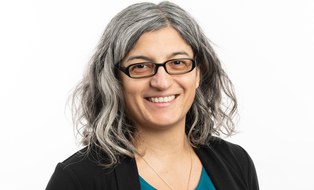 © Sven Ellger/TUD
© Sven Ellger/TUD
Advice on studying abroad
NameMs Federica Serra
Infocenter/ Study abroad; TUDworldwide: America
Send encrypted email via the SecureMail portal (for TUD external users only).
Visiting address:
Fritz Foerster Bau, Office 161 Mommsenstraße 6
01069 Dresden
Postal address:
TUD Dresden University of Technology International Office
01062 Dresden
Office hours:
- Tuesday:
- 09:30 - 11:30
- 12:30 - 14:30
- Thursday:
- 09:30 - 11:30
Please register at the SCS (FOE, floor 0).
Looking for first-hand information?
Would you like to know more about Indonesia? Ask our alumni ambassadors - TUD alumni who are active in many countries around the world and can give you information and advice for your stay abroad.
Getting in touch is very easy: On this interactive world map, markers indicate the cities where our alumni ambassadors live. There is a short profile with contact information for each ambassador.
Partner Countries Archive
Have you missed a partner country? No worries! Here you can read up on all articles.
|
Europe (Erasmus+) |
|
|
Africa |
|
|
America |
|
|
Asia |
|
|
Australia and Oceania |
|

